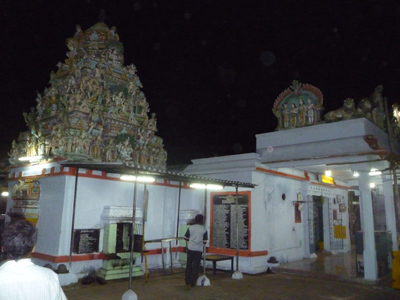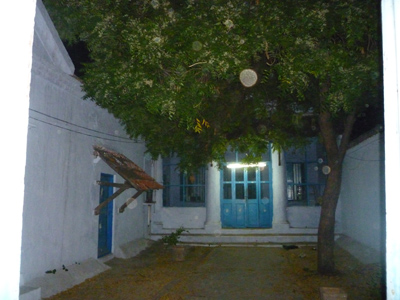|
I have long been vaguely aware of a Kasi Viswanatha Swami Temple in Ayanavaram. But though I happen to pass Ayanavaram at least once a week on work, I have never bothered finding out where in that bustling suburb of Chennai stood this temple. More recently, I saw that it was one of the 400 and odd heritage structures listed by the Padmanabhan Committee and duly notified by the High Court of Madras. It was, however, young Karthik Bhatt who, given his Gujarati lineage, was, quite naturally, more interested in the shrine, for it had been built by that community. And when he informed me one hot April afternoon that the temple was celebrating its annual festival and the Rishabha Vahanam procession (the deity being taken around on a silver bull) was scheduled that night, I decided to go along with him. “We can also see the Tawker Choultry,” he added enticingly.
 Kasi Viswanatha Swami Temple, Ayanavaram.
The Tawker Choultry. |
The temple is very close to the Medavakkam Tank Road and abuts the Ayanavaram Bus Stand. In fact, I ought to put it the other way round, for the Bus Stand was built on land taken over from the temple, as I was to discover later. The shrine is, however, completely hidden from view by a row of shops built to front the main road. You access the temple proper either through an entry arch between the shops or through the main entrance which is in a street off the main road.
The temple owes its existence to the Tawkers, a clan which, though of Gujarati origin, had moved South and made Trichy its base in the 1700s. In fact, most members used T as their initial, thereby establishing their connection with the historic town of the Rock Fort. The most famous among the Tawkers was, of course, T.R. Tawker who later moved to Madras and had a Henry Irwin-designed showroom on Mount Road. This branch of the Tawkers became insolvent in the 1920s. Those who were responsible for the temple were, however, of a collateral branch and an inscription on a granite slab let into the doorway of the temple mentions the name of Viswanatha Tawker. It was, however, two women of the family who really were the primemovers and this was around 200 years ago (a very convenient figure for most things historical in our city).
 The Tawker Choultry. |
Ramkor Bai and Ratna Bai were sisters who were either directly descended from or married into the Tawker line. They were wealthy in their own right and, according to family legend, had at one time even lent money to the East India Company to finance its cloth trade. They had been on a pilgrimage to Varanasi and brought with them two Shiva lingas. One was enshrined at the Motta Utara on Mint Street, the larger of the two congregational centres for the Khedawal community of Gujaratis in Madras. The sisters planned to consecrate the second linga on land owned by them at Ayanavaram. A vast expanse was demarcated and the shrine was duly built, complete with a modest tower, a courtyard, some sub-shrines and a sanctum with two shrines in it, one for Kasi Viswanatha Swami and the other for his consort Visalakshi. A tank was excavated across the road. It is said that the sisters had planned to build a companion shrine for Vishnu as well, probably on the lines of the Chenna Kesava and Chenna Malleeswara Temple of George Town. But a burglar made off with the money earmarked for the second project and so it never materialised.
In order to ensure a permanent source of income for the temple, the Tawkers built a row of single-storey, tile-roofed street houses in a line that runs parallel to the shops that front the road. Each has a low entrance, a vestibule leading to a central courtyard and a few rooms including a kitchen leading off it. A well was dug for each house to ensure water supply. These were to be rented out to middle-class families. This row, protected as it is from the main road by the row of shops, has remained completely intact and, being in continuous use, is in a fair state of preservation. The line of houses reminds you of the agraharam (the first circle of houses around a temple) in any village in Tamil Nadu.
At the end of this street stands the Tawker Choultry. Entered through tall doors, it was meant originally as a guest-house and is now a hostel for indigent students. Around a central courtyard are rooms meant for senior students and a dormitory for newcomers. The rooms are spartan, equipped with a stone couch and a few pegs to hang clothes on. The roof is a combination of Madras terrace and Mangalore tiles. Meant to accommodate at least twenty students, it houses a solitary boy now. The locals say that several of those who studied in Chennai thanks to the Choultry are now senior officials in the Government and in the private sector. And some have come back to see the place which was responsible for their success in life.
The Tawker line that built the temple died out over time and the administration passed on to the Dagat family and, from them, it came to the Daveys. They take care of the well-being of the shrine and the Choultry. An intriguing tale has persisted in the family. Apparently, the money loaned to the East India Company was never returned and the Government of Madras continued paying interest on it till independence and this was in turn passed on to the temple administration. Post-independence, however, the payment was stopped and the hereditary trustees took the matter to court. The judgement was in their favour and the principal amount was returned, the exchange rate for the pagoda vs the rupee being calculated for the purpose!
Over the years the temple lost a lot of its surrounding land. The Ayanavaram Bus Depot, Annai Sathya Nagar and other residential colonies came up on land acquired from the shrine by the Government. The Tawker sisters evidently planned a huge temple chariot to load the deity on, for which a flight of steps was built abutting the temple wall. Today the staircase leads to the roof of the bus depot! New constructions also saw the tank being separated from the temple by the main road.
The temple and its precincts are, however, in an excellent state of repair and are evidently well-administered. I was introduced to the Davey brothers who now are in charge, several of them living in other parts of India but all of them making it to the annual festival, despite age. There was a good turnout for the Rishabha Vahanam. The God took His time to get ready and it was past midnight when, to the accompaniment of the nagaswaram ensemble and a Western orchestra, the deity was brought out. The festival of nine nights sees the Goddess being similarly feted and music concerts are also conducted in the courtyard during the time.
I leave the place at around midnight. A packet of puliodarai (tamarind rice) was pressed into my hand as I left. Back home and hungry for a midnight snack I ate it and found it to be excellent. It carried with it a flavour of a village festival, a spirit that the Kasi Viswanatha temple has maintained intact despite the city having swallowed its neighbourhood.
|